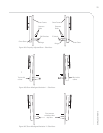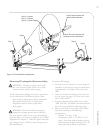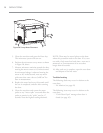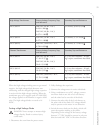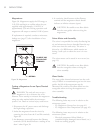
30 OVEN SYSTEMS
NOTE: The terminals with the orange dot or the
orange wire always go to Terminal
3 on US models.
To verify correct wiring (International), measure
the voltage between the taps on FT1 and FT2. The
voltage must be 220 VAC (Latin America), 200
VAC (Japan), or 230 VAC (International).
High-Voltage Transformers
High-voltage transformers are a ferro-resonant
design which limits fault currents and minimizes
magnetron power changes due to input voltage
changes. The high-voltage transformer supplies the
high voltage for the Voltage Doubler Circuit. They
are controlled via the K2 relay.
Wiring the High-Voltage Transformers
DANGER: Never attempt to wire or
measure the secondary voltage values of the
high-voltage transformers with the high-voltage
transformers enabled. Lethal voltage will be present.
The proper reinstallation of a high-voltage
transformer is critical. Upon removing a high-
voltage transformer, make sure to note where each
wire was installed. Refer to the oven schematic
(page 51) detailing the proper wiring.
As shown in the schematic, transformers are
installed mirror opposite and wired
180
º
out-of-
phase. It is essential for longevity that the high-
voltage transformers remain 180
º
out-of-phase. This
can be checked by placing a volt meter across
terminals
T1-1 and T2-1 (primary voltage).
With the microwave system energized, the volt
meter will read
the incoming voltage (different
readings for different electrical installations).
If the
meter reads
0 VAC, the high-voltage transformers
are most likely wired in-phase. As a last check,
energize the microwave system and verify the
voltages between the taps on each high-voltage
transformer.
The wiring issue must be corrected prior to return-
ing the oven to service, as the voltages must be:
-
NORTH AMERICA: 208 VAC between 1&2and
240 between 1&3.
- LATIN AMERICA
: 220 VAC
- JAPAN: 200 VAC
- INTERNATIONAL: 230 VAC
NOTE: The terminals with the orange dot/orange
wire always go to terminal
3 on USA models.
Testing a Filament or HV Transformer
DANGER: Never attempt to measure the
secondary voltage values of the transformers
when they are enabled. Lethal voltage will be
present.
1. Disconnect the AC power source and discharge
the high-voltage capacitors.
2. Disconnect all the wires in question going to the
transformer.
3. Use an ohmmeter to check the impedance of the
primary and secondary winding. Refer to the
adjacent resistance table to determine if the
transformer is OK. If the resistance is different
then the table indicates, replace the transformer.
High-Voltage Diodes
The high-voltage diode (Figure 29) is assembled by
connecting several 1000-1500 volt semi-conductor
diodes in a series to increase the reverse voltage
capability. In the circuit, the high-voltage diode
conducts to prevent the filament voltage from
becoming positive, thus as the high-voltage winding
of the transformer goes to 2400 VPK, the high-
voltage capacitor is charged to 2400 volts.
Figure 29: High Voltage Diode






